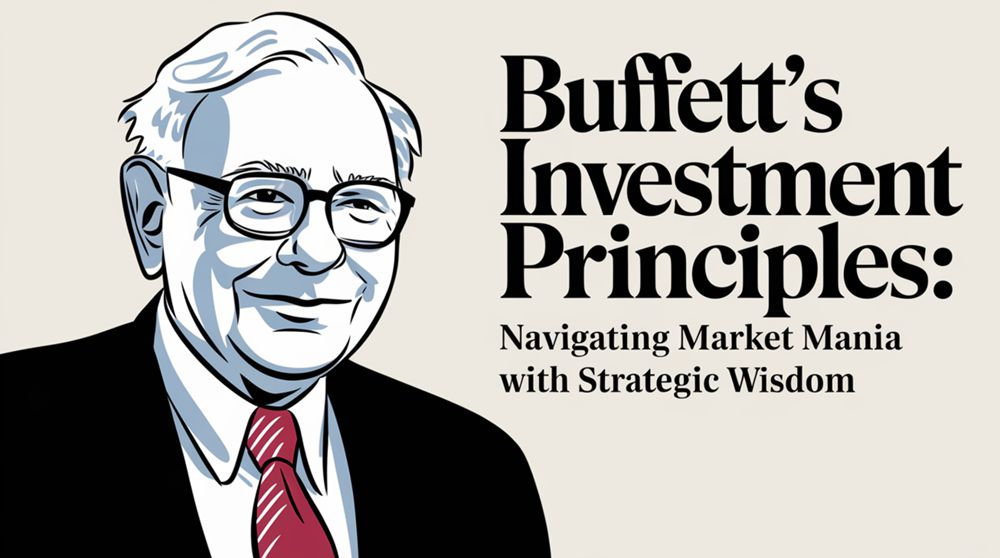Buffett’s Investment Principles: Navigating Market Mania with Strategic Wisdom

Understanding Buffett’s Core Investing Principles
1. Value Investing: The Bedrock of Buffett’s Philosophy
At the heart of Buffett’s approach is value investing, a strategy that involves buying stocks that are undervalued relative to their intrinsic worth. This concept, popularized by Benjamin Graham, emphasizes the importance of understanding a company’s future cash flows and economic moat—a term Buffett uses to describe a firm’s competitive advantage. By focusing on intrinsic value, Buffett aims to purchase “wonderful companies at fair prices” rather than “fair companies at wonderful prices.”
2. The Circle of Competence: Investing Within Your Knowledge
Buffett is a firm believer in the “circle of competence” principle. He advises investors to only engage with businesses they thoroughly understand, thereby minimizing risks associated with unfamiliar industries. This approach ensures that investment decisions are made based on informed analysis rather than speculation or market trends.
3. Long-Term Holding: Patience as a Virtue
Buffett famously states that his favorite holding period is “forever.” This long-term perspective allows investments to benefit from compounding returns, reducing the impact of short-term market fluctuations. By holding onto quality stocks for extended periods, Buffett capitalizes on the underlying business growth rather than short-term price movements.
4. Management Quality and Rational Capital Allocation
Buffett places immense value on the quality of a company’s management. He looks for leaders who are transparent, honest, and capable of making rational capital allocation decisions. Companies that return excess capital to shareholders and resist following industry trends blindly are particularly attractive to Buffett.
5. Financial Health: Key Indicators to Watch
Several financial metrics are crucial in Buffett’s analysis:
- Return on Equity (ROE): A measure of how effectively a company generates profits from shareholders’ equity.
- Profit Margins: Reflect operational efficiency and pricing power.
- Debt Levels: Low debt reduces financial risk, a key consideration for Buffett.
6. Margin of Safety: A Cushion Against Uncertainty
Buffett insists on a significant margin of safety when investing, which means buying stocks at a price well below their intrinsic value. This buffer protects against errors in judgment and unforeseen market events, ensuring a degree of safety in the investment.
Buffett’s Current Market Moves: Cashing Out Amidst Market Mania
In recent months, Buffett’s actions have captured the attention of the financial world. Berkshire Hathaway has been a net seller of stocks, unloading over $36 billion in the third quarter of 2024 alone. This move raises questions about the current state of the market and Buffett’s strategic thinking.
Why is Buffett Selling Now?
- High Market Valuations: Buffett’s recent sell-off, particularly in tech giant Apple, reflects concerns over high stock valuations. With the S&P 500 trading above its historical averages, Buffett appears to be taking a cautious stance, wary of potential market corrections.
- Record Cash Reserves: Berkshire’s cash holdings have soared to an unprecedented $325 billion. This massive cash pile suggests that Buffett is preparing for future opportunities, possibly waiting for market valuations to become more attractive.
- Economic Indicators: The current economic landscape, characterized by an inverted yield curve and declining money supply, may be signaling potential downturns. Buffett’s cautious approach could be a response to these warning signs.
- Tax Considerations: With potential changes in capital gains tax policies, Buffett might be strategically positioning Berkshire to minimize future tax liabilities.
Buffett’s Latest Top Holdings
Despite the significant sell-off, Buffett continues to maintain substantial stakes in several key companies. As of the latest reports, here are some of Berkshire Hathaway’s top holdings:
- Apple (AAPL): Although Buffett has reduced his stake, Apple remains a significant part of Berkshire’s portfolio, valued at approximately $69.9 billion.
- Coca-Cola (KO): A long-time favorite, Coca-Cola is valued at $28.7 billion, reflecting Buffett’s confidence in its enduring brand power and stable dividend yield.
- American Express (AXP): With a valuation of $41.1 billion, American Express continues to be a cornerstone of Berkshire’s financial sector investments.
- Chevron (CVX): Worth $17.5 billion, Chevron represents Berkshire’s interests in the energy sector, albeit with a cautious outlook given recent market conditions.
- Bank of America (BAC): Despite recent reductions, Bank of America remains a key holding, underscoring Buffett’s strategic focus on financial services.
Conclusion: Navigating the Future with Buffett’s Wisdom
Warren Buffett’s investment strategies offer timeless lessons for investors navigating today’s volatile markets. His emphasis on intrinsic value, long-term holding, and financial prudence serve as guiding principles in an era of market mania. As Buffett navigates these turbulent times with a cautious approach, individual investors can learn from his disciplined methodology, focusing on quality, patience, and strategic foresight.
In the end, Buffett’s actions remind us of the importance of staying grounded in fundamental analysis and maintaining a long-term perspective. As markets continue to evolve, his principles serve as a beacon for those seeking to build sustainable wealth amidst uncertainty. Whether you’re a seasoned investor or just starting, embracing Buffett’s wisdom can help you make informed decisions and thrive in the ever-changing financial landscape.
Send us a Message
Contact us
Contact us today to learn more about Kavout's products or services.

